Welcome to the Epic Onpage SEO guide.
This guide is aimed for the beginner, but can be a good reference for everyone else.
Everything on this page is what you need to be aware of to become an on-page SEO expert.
You will learn:
- How to layout your pages
- How to optimize your pages
- Everything else onpage related
By getting the on-page correct, your articles will be in the best position to rank.
This is a fundamental pre-step before you even start thinking about “off page” SEO, e.g. link building.
The great thing about on-page SEO is that it doesn’t change that much.
Google may ban links, remove sites it thinks is link spam but anything you do on your page that improves your visitors experience will always be safe in Google’s playbook.
In many cases a site that is well structured and optimized for SEO will have an edge over its competition.
Contents
Free Tools
Your first step into onpage SEO optimization begins with installing and using some free tools.
All the plugins recommended below are for sites created using WordPress, a completely free blogging platform.
Yoast WordPress Plugin
The very first plugin you need to install is called the Yoast plugin.
This is a very popular plugin for onpage SEO optimization and the basic features are free, which is more than enough to get started with.
The plugin gives a checklist of things to be edited or added to a post to make it more SEO friendly and is considered the basics of onpage SEO.
Installation
Login to WordPress setup -> plugins.
Search for “Yoast SEO”
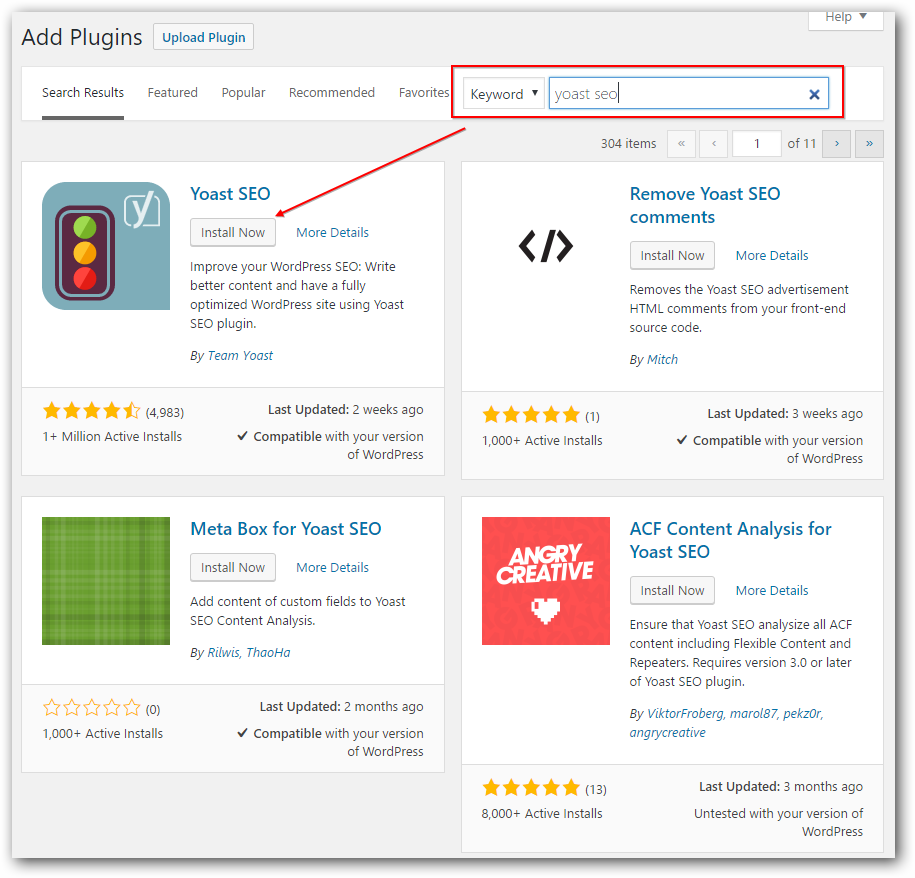
Click “Install Now” and don’t forget to activate it.
Usage
The most important section is the Focus keyword box.
Set the focus keyword and follow the recommendations on the analysis section.

The analysis items is a simple check list of basic onpage optimization. Making items green will go a long way to prepare your content for search.
You can see the overall status of your article in the publish box.
The W3 Total Cache Plugin – Site Speed Optimization
Your page load speed influences your pages ranking potential.
According to WordPress, a site has only 3 seconds to capture the attention of first-time visitors. Online consumers expect a webpage to load in less than 2 seconds.
Visitors will abandon a site if it loads slowly and are likely to return to a slow website.
The W3 Total Cache will speed up your WordPress site dramatically and it is free!
Installation
To install W3 Total Cache in WordPress:
- Uninstall all other caching plugins like WP Super Cache as it may cause issues
- Go to WordPress admin panel, click on Plugins -> Add New -> Search for “W3 Total Cache”
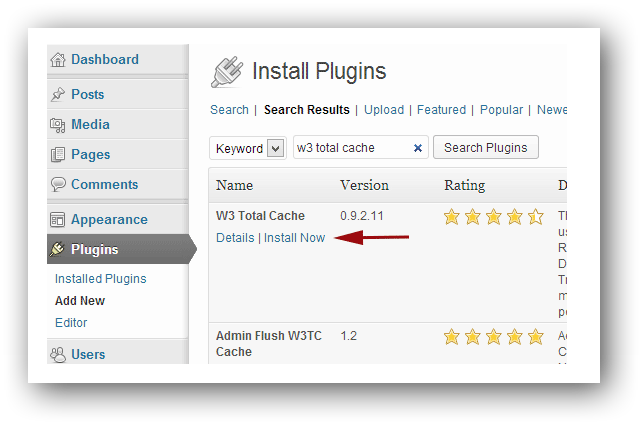
- Click on Install Now and activate the plugin
Settings and Configuration
From the WordPress admin panel, go to Performance -> General Settings. Make sure you are on the General Settings and not on the promotional Dashboard page of this plugin.
- Enable Page Cache to create static cache pages and reduce load time
- The Disk: Enhanced method is recommended for shared hosting which is used by most beginners
- Go to Browser Cache, click Enable then Save all settings
- Don’t forget to ” Save all” settings
- You may enable Minify, Database Cache and Object Cache if your hosting server is optimized for these settings.
Page Keyword Density Checker
A nice backup tool to check keyword density is the Page Keyword Density Checker.
Using the same keywords in an article too many times may be regarded as keyword spamming.
http://tools.seobook.com/general/keyword-density/
This tool gives keyword densities for all words on a web page while the Yoast SEO plugin only gives keyword density for the focus keyword.
Usage
Just paste the link of your website page and submit.
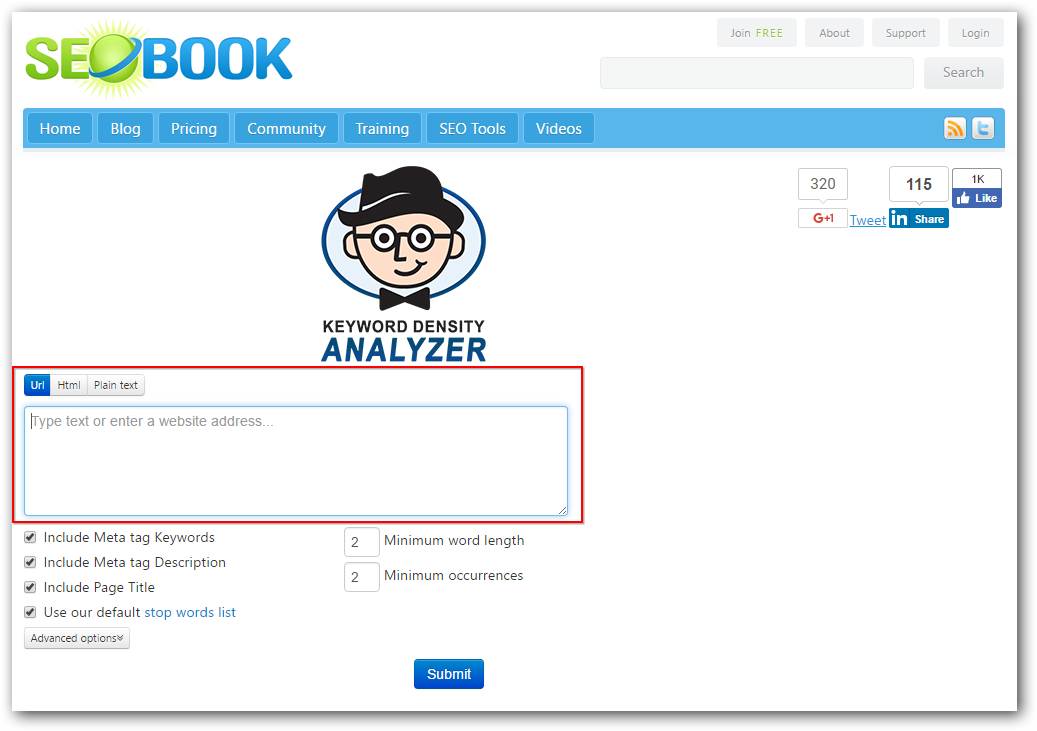
A detailed breakdown looks like the report below:
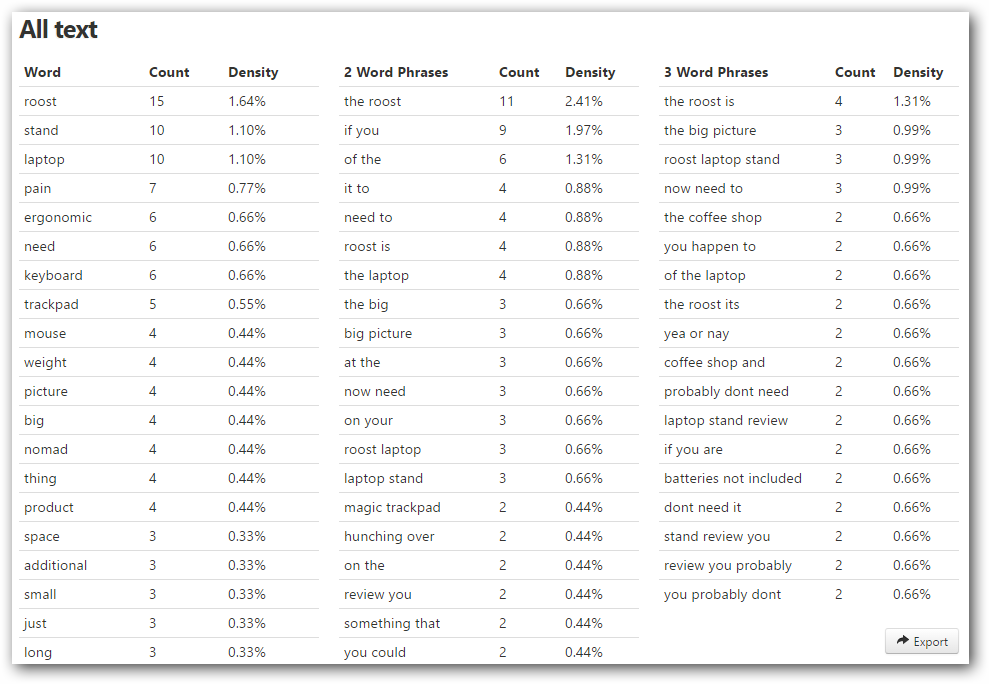
The point of keyword density is to steer away from excessive word repetition. Note that
- Cheap and low quality articles tend to be fairly repetitive.
- Low density means you are forced to use greater word variation.
Rather than focus on a specific keyword density threshold, decrease its usage and find synonyms and other related vocabulary instead.
Google’s own remote rater guidelines was leaked to the public. It tells its raters to mark low-information repetitive content as spam.
The real opportunities of density checking are:
- Comparing content to competitor sites and discovering phrases and words you can use for your own content.
- Seeing if your content is out of sync with what Google is ranking on the top.
- Checking if your content is natural or using excessive repetition.
Google Analytics
Another tool worth checking is Google Analytics.
You will need to sign up for it (its free) and install a simple javascript tracking code.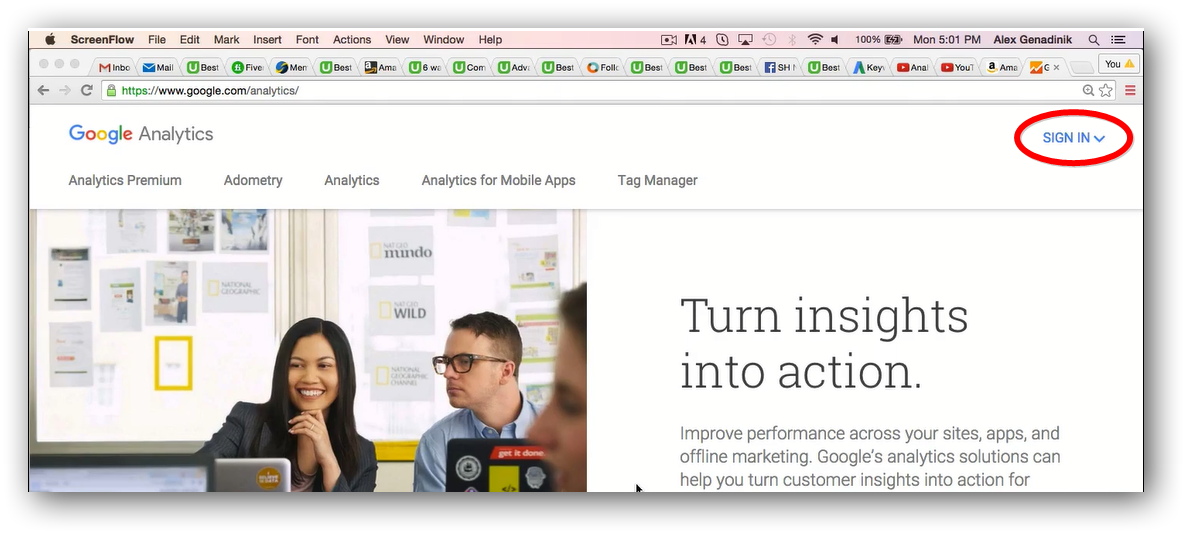
Once you have it installed GA it will start to gather data on your site visitors for you for free.
GA gives you a lot of free features such as:
- A/B testing via experiments
- Tracking where exactly your visitors click on and what pages they visit
- How long they spend on your site
- Bounce rate
Even if you don’t know what to do with it yet, just install it so that you have the data for it ready when you need it.
Google Keyword Planner
When writing content for your blog, each article must target a single main keyword phrase.
What is a keyword phrase? The free and best way to find out:
- What people are searching for
- How many people are searching for it
Is to use the Keyword Planner Tool by Google Adwords. Create a free Adwords account before using this tool to remove any restrictions associated with the public version.
If you wanted to write about “Dog Training” the keyword planner would give you the following ideas.
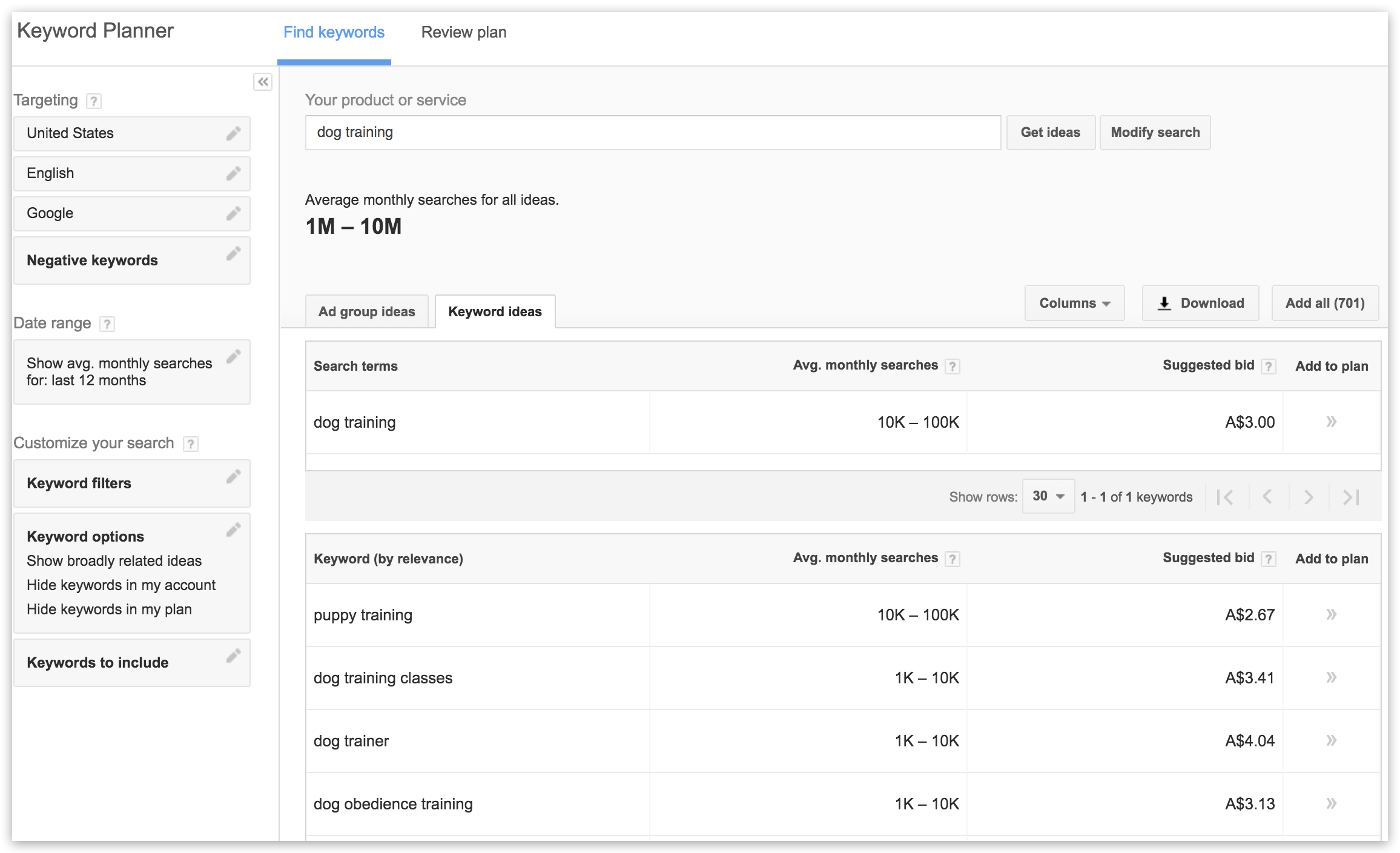
As you can see, besides the initial search term “dog training” you get an estimate of how many people are searching for it !useful!
Underneath is a listing of other keywords that are relevant to the main keyword !very useful!
You can use the keyword listings to explore new article ideas, shore up the keyword targeting in an article by including long tail keywords and finally get a rough idea of keyword competitiveness by looking at the suggested bid.
Keywords Research
The following are simple ideas you can use to filter and prioritize what keywords to target.
Keyword Selection
The most important thing is to write about one keyword per article.
You can confuse both your readers and Google by targeting multiple un-related keywords.
Don’t do it.
Keyword Intent
Pick buying keywords.
When people start a search on Google, they are at different stages of the buying cycle.
The image below from iformat.com summarizes the cycle.

The search words they use will denote their intention to buy. ie the keyword intent.
A keyword like “buy product xyz” has a higher keyword intent than “product xyz review”.
You want to rank for buying keywords as they convert best.
Not surprisingly, buying keywords can be more competitive to rank for.
Targeting less competitive keywords that educate your customers in the “research” phase is also a valid strategy.
Keyword Trend
When choosing keywords, some are increasing in popularity while some are “dead” keywords with little to negative growth in search volume.
The best tool for checking keywords is Google Trends.

A very useful section is the related topics and queries as it can clue you unto new keywords that might be on the rise.

Long Tail Keywords
You can group keywords by its length and its potential to generate traffic for your site.
In general the longer the keyword phrase is, the more unique it is likely to be and the less traffic it will generate. As there are so many long tail keywords out there, it is impossible for one site to try and target them all.
You should target both long tail keywords and shorter more competitive keywords.
However by targeting long tail you will inadvertently be targeting many shorter competitive keywords anyway.
An example is the easiest way to find long tail keywords and how they differ from more competitive keywords.
For example, the term “business ideas” is considered a competitive keyword as it is just two words long and has around 22k searches a month. This keyword has further variations, including:
- homebased business ideas
- online business ideas
- best business ideas

However if you drill down further you will find keywords such as the following.
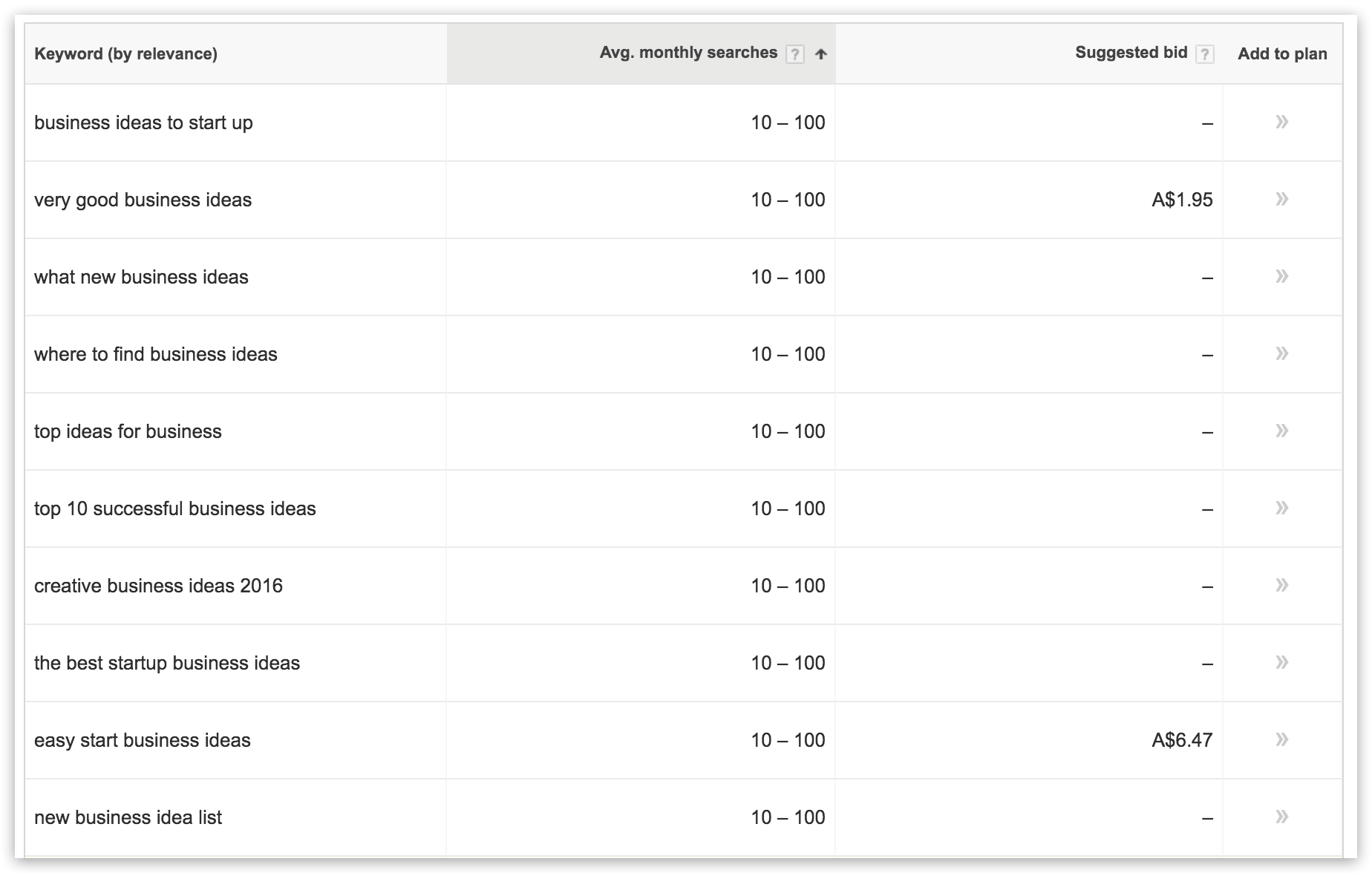
The search volume is much less at 10-100 a month.
However the keywords tend to be more unique such as “creative business ideas 2016”. It is easier to try and rank for that term than for just “business ideas”.
Keep in mind:
- Long tail keywords can be time limited or seasonal (eg “2016”)
- With less search traffic, most sites will not actively try to rank for it and thus there is less competition.
- Ranking for many long tail keywords, means that if one or two keywords falls out of the search engines your overall site traffic will not be adversely affected.
- You will need to create a lot of content to see any real traffic growth if you are targeting long tail keywords only
Example: How to use short & longtail keywords
Lets go through a real life example to see how short and long tail keywords can be used together.
Imagine we are going to write an article about “Facebook marketing”. That is our primary keyword.
If we pulled up the Keyword Planner we can target other longer tail but related keywords such as
- Facebook marketing strategies
- How to promote your business
- Facebook marketing for business
- Facebook for business
We would then craft an article about “facebook marketing” and while writing incorporate content that covers the long tail keywords we are also targeting.
For example your article might look like this…

I have bolded the keywords to make it easier to see that I have mixed in the main keyword and long tail keyword seamlessly in the article.
The advantage of doing this?
You will start ranking and generating traffic from the long tail search queries initially and as you build links to the article and your site gains authority, over time that article will start to rank for more competitive shorter keywords and traffic to the article will grow.
Other keyword tools
Here is a list of some other keyword tools you can use:
Onpage Elements
Every article that you publish should have the following basic elements to help it rank.
For some non-competitive keywords having a solid on page optimized article can be enough.
For competitive keywords, having the right on page elements is going to be a fundamental part of getting the most out of your link building work.
The first thing a page should have are correct title and meta description tags.
Ideally your keyword should appear in both the title and meta tag.
The meta tags aren’t as useful for ranking, however they are shown to users and its an excellent place to put in a call to action.
Right clicking any in a browser page to view its source is simple way to check for title and meta tags.
Press Ctrl+F to access the find window and type in “Title” and “META” to double check that the correct title and meta tags are set.
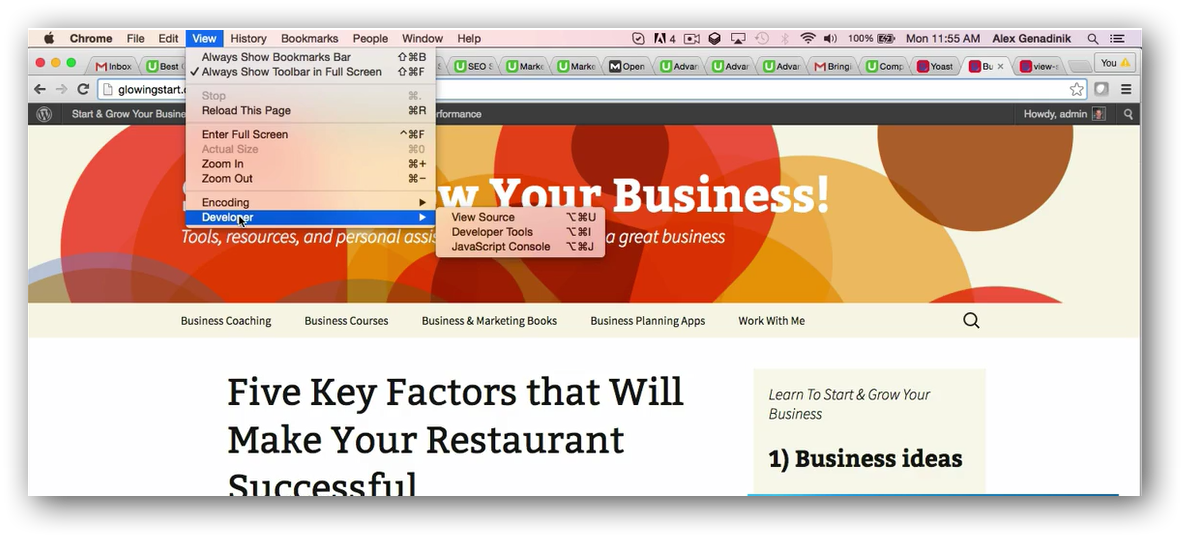
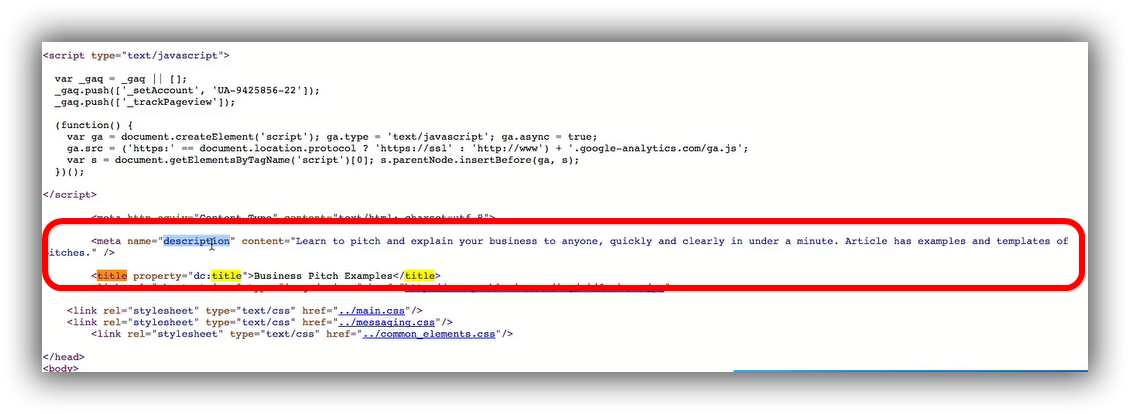
Why are these elements important? Because Google will show these in the search listings.
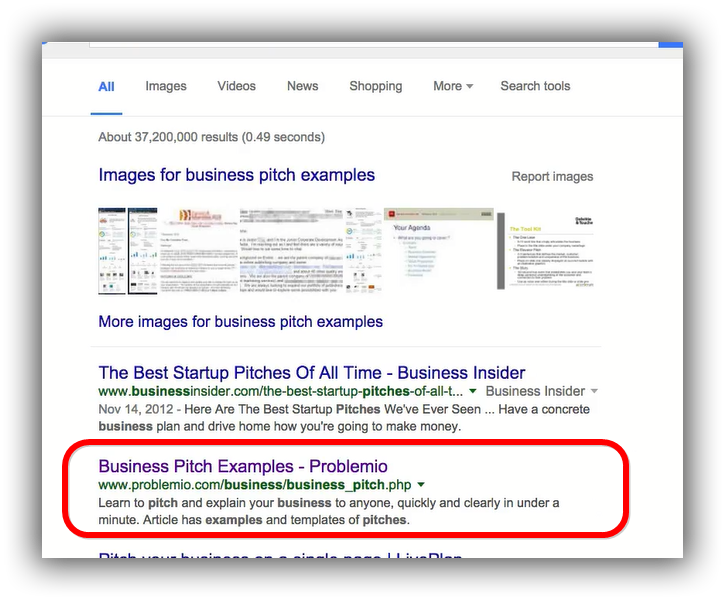
Another easier way to verify what Google will show is to use an online Title & Meta checker like the following.
Google Meta Title & Description Length Preview Tool Measures in Pixels

There are some size limitations you should be aware of too:
- 70 characters in the title tag
- 140 characters for the description
Bang For Your Buck
It is super important to have at least your title filled out correctly.
Although no one knows exactly how search engines rank articles precisely, we do know that of all the elements on a page, your title plays a big part of its ranking.
Filling out the title and meta tags is one of the easiest things to do on website that will gain you better rankings.
It only takes two minutes to setup your title with a keyword and customize the meta description. To see how exactly to do this check out the last section on using the Yoast plugin to setup the on-page elements.
Google and other search engines no longer use keyword meta tags due to their history of being abused by spam sites.
The video below from Matt Cutts explains why.
Post Url
The title of your article should appear in the url of a post.
SEO friendly URLs contain the keyword that the article is targeting and are easy for both humans and search engines to understand.
For WordPress based blogs, this is setup for you automatically.
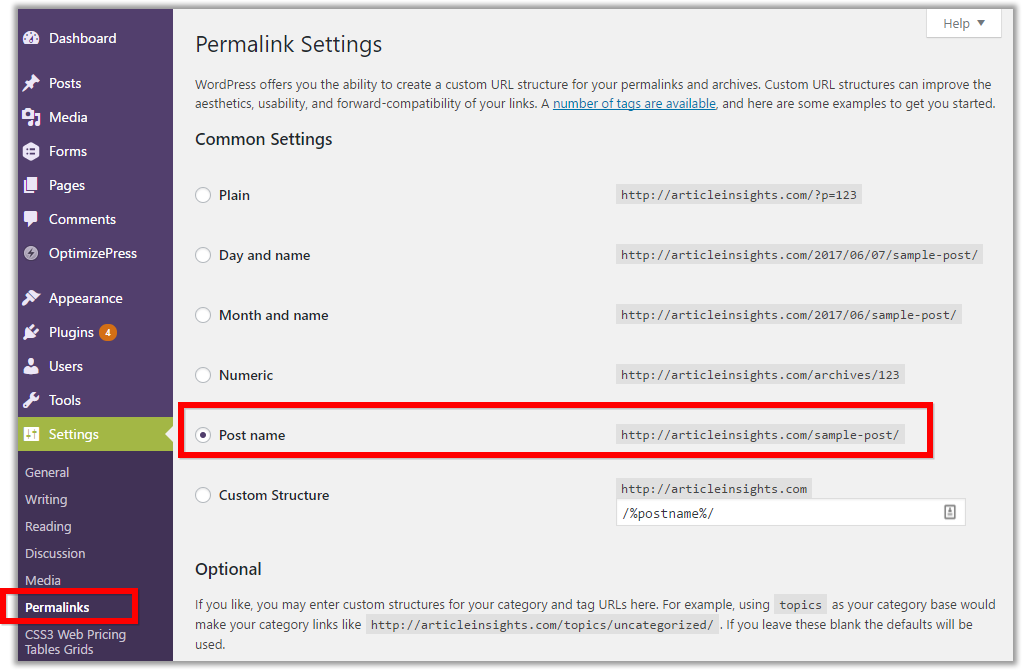
If you are using any other blogging system, you should set it up to use the post title as the url.
Just plain text on a page is bad, the biggest reason is that you risk losing readers when all they see is a wall of text.
Its good for readers.
Having images, videos and structuring your content with headings directly affects your pages bounce rate and time on site.
Both metrics that Google can track and can use in the ranking algorithm.
Its good for on page SEO.
Strategically placing your keywords in image alt tags and header tags can further optimize your onpage SEO.
Header tags are also important and natural places for you to put in long tail keywords.
The H1 tag is the most important heading tag, you should at least have that tag optimized with your keyword.
Outbound links
The links you send to a page are very important. This is off page SEO.
Similarly the links you include in your articles are also very important, these are called outbound links.
At worse, linking to “Bad Neighbourhoods” can net you a search penalty in Google. Read more about “bad links” on the ahrefs.com site
However, adding links to authority websites such as .gov and well known sites in a niche can potentially increase the trust score of your article and hence improve its on page optimization.
Article word length
How long should a page or post be?
There are some blog posts that have 100 words or less and rank because they have a photo, video or a podcast embedded in them.
Longer posts on the other hand give you opportunities to create really useful content.
At least 300 words
You should aim to write at least 300 words.
Keep an eye on the page to see if it ranks. If not, you should add 300 more words, or even more photos or videos.
Review your pages constantly as some of your articles can become cornerstone pages, that rank the highest and brings the most traffic and engagement.
Long blogs can become eBooks
Blog posts with 4000 or 5000 words can actually become like small kindle books that can be sold for $0.99 cents or something but that is a whole different story. What really happens is Google wants to see a a definitive content, one that covers much but it does not mean to just spill words or repeat things.
Furthermore, if the topic covered is wide enough, then it is good to have sub-sections.
A content can rank better for long tail and short tail keywords. A definitive post can get links because people will easily see it.
Cornerstone page
Making a page authoritative is a good Segway as it brings the concept called cornerstone pages.
A cornerstone page that describes a definitive page is not an official term. The point is having photos or videos like popular YouTube videos that can be embedded on the page. It works best if the content is really great, something that will be easy for people to read.
A page that is easy to skim or easy to get through has a relatively low balance rate. Have a good definitive content if you want to make the best page on the web about the keyword you try to rank for that is a cornerstone page. That will have a higher chance to rank.
Can anyone make a cornerstone page with every blog post?
That is possible but it will take a long time. Doing it smart is good.
If one is trying to rank for a keyword that is easy to rank, he does not have to go for a cornerstone content because it is really expensive considering the amount of time and effort being invested.
It is when going for the competitive keywords that making a cornerstone content applies. It is putting up a blog post that is a good to be targeted with well-chosen long tail and short tail keywords.
A cornerstone page has very wide topic coverage and it is best not to over invest in it if not necessary, or if one is just starting.
A 500-word post which ranks can be enough. Anyone will eventually be smart in keyword targeting. It is recommended to start off with few hundred page posts and see what they can do from there.
Internal post linking
It is good to build links called backlinks into a website, but there is another thing that can be done – building backlinks throughout the site by the smart interlinking of pages. A significant part of a site is the navigation link at its top which can be ranked, the Home Page.
See if a content that is linked intelligently and timely makes sense to other blog posts. For example, many people want to link “start a business” and it goes to another page within the website about “how to start a business.”
Link to your target customers the target market article then link to a product strategy and business planning. The links may not be too many but your content itself can give you ideas what to write about next through the keyword.
Business-related keywords are interesting because they can generate business ideas. You can use the Google keyword tool and see what kind of demand that search keyword has.
Building links from other sites to your website can make your site authoritative and that is off site SEO which is another story.
Advanced interlinking
There is a way to make a page link to itself and that is going to give the whole bunch of extra links super relevant. It is going to look like basically putting in the blog post links to its different sections post because some blogs are a little bit long.
If you click on the link from the blog post, the URL changes to hashtag and it takes you to the section the post targets. You can click into different ones which will take you to another section. Use WordPress’ HTML feature where you can copy and paste a website’s URL.
A regular Href can be used but there is likewise a hashtag with a name. It is not an Href but a name tag and the HTML that redirect to the destination section. The name can be any given label.
If the site has 5 extra links pointing to itself, it can boost ranking of that site. Keywords can be used too like “fire marketing 1,” “fire marketing 2, 3 or 4.”
Using extra keywords into this hash thing is getting a lot more SEO goodness when more SEO nest, more SEO power are squeezed into the page pretty powerfully. Almost no one else does this so it can give a bit of a boost advantage over everybody else.
Bounce rate
The Google Analytics can be used to check out a webpage’s bounce rate and improve it. Logging into Google Analytics will show a dashboard with some traffic information.
Pages per session can be very low. One of the reasons is that the homepage of that site tries to sell products that is off the site. Hence, the site tries to get people to go away from itself and go to other sites like Amazon or direct them to apps that they can download.
Site content can be a landing page, such as the homepage, business page and target market page – the pages most landed on. The bounce rate can be high when people are just coming to the site searching for articles. The site can have almost 90 or 80 percent bounce rate which is really bad.
Another cause of a high bounce rate is a badly designed website. People see it and immediately leave.
Good articles can lower the bounce rate because visitors likely stay to read them.
Sort through your pages and check those with less bounce rate. Learn from them what you can do with pages with more bounce rate so their bounce rate will decrease too.
Tips for decreasing bounce rate
For instance, a web page’s bounce rate is high in week 1. To lower the bounce rate, doing design enhancements on that webpage may help; or put something so people would not bounce elsewhere. It could be an image or more content that can lead to more engagement so visitors navigate more.
The more professional and high quality the page is, the more the bounce rate would decrease.
If people leave so often, it means they do not have a lot to do with the site.
The bounce rate goal should be 50 percent.
Retain your customers and have them navigate throughout the site more. That will give positive signs to Google and help the site rank higher.
Onpage Setup Using Yoast
The meta tags, title and description tags for the home page can be set up, not on the post. It is an important distinction because for almost all sites the strongest page on the site for SEO is the Home page. Hence, it is vital to specifically set up the Home page title and description meta tags.
Do the following:
- Check out the blog goingstart.com
- Go to (Chrome) view, developer and view source.
- The page source comes out
- Press Ctrl + F and then search for title. This is the title meta tag which does not appear on the actual page but gets to put up to 70 characters of keywords.
The keywords the owner tries to rank are:
- business plan apps
- books
- courses
- business coaching
The keywords are important as Google looks for the keyword being put on the page. As for the description meta tag, it can be twice longer than the title tag.
To set up the keyword, go to your WordPress setup, then click SEO.
It will appear when the Yoast is installed as it is going to actually show the General screen and the Home tabs. Click the Home tab. This is how the title and description are set up. Click Save Changes.
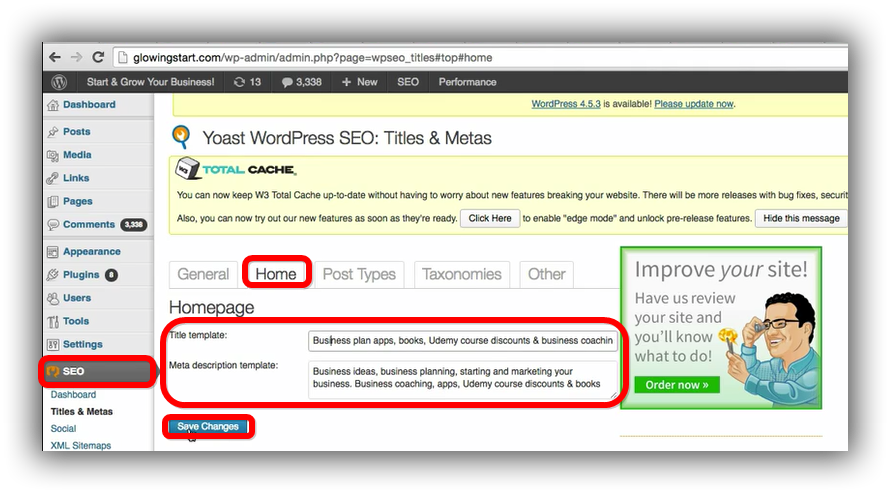
For every post and page, it is actually much simpler to set up a regular post title and description meta tags.
When making a new post, scrolling a little fast will lead to the SEO title and SEO meta description; otherwise, the existing one can just be edited.
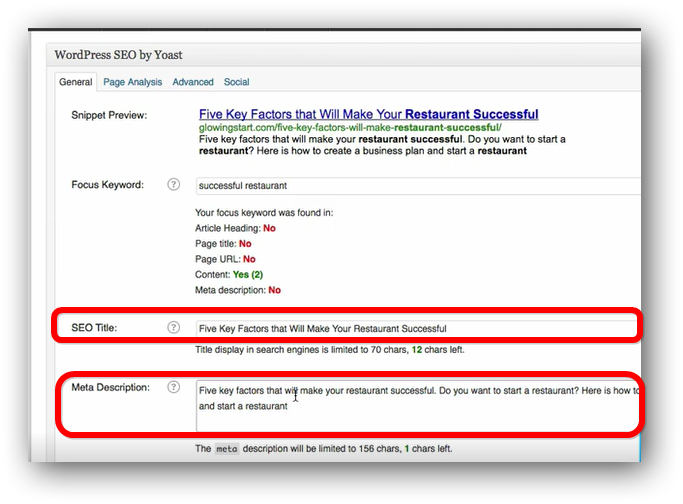
Just fill the form out.
It is important to know the difference in making a distinction between the homepage and the individual posts. A lot of people simply had a hard time finding a way to navigate how to set their home page meta tags title and description.
Set them in different places. Set the homepage meta title and description tags in one place and set every other individual blog post right in the blog post because there can be a lot of hard time finding it, and there would be no confusion.
So every page on the site should have the title and meta description tags completely filled out and they should be optimal.


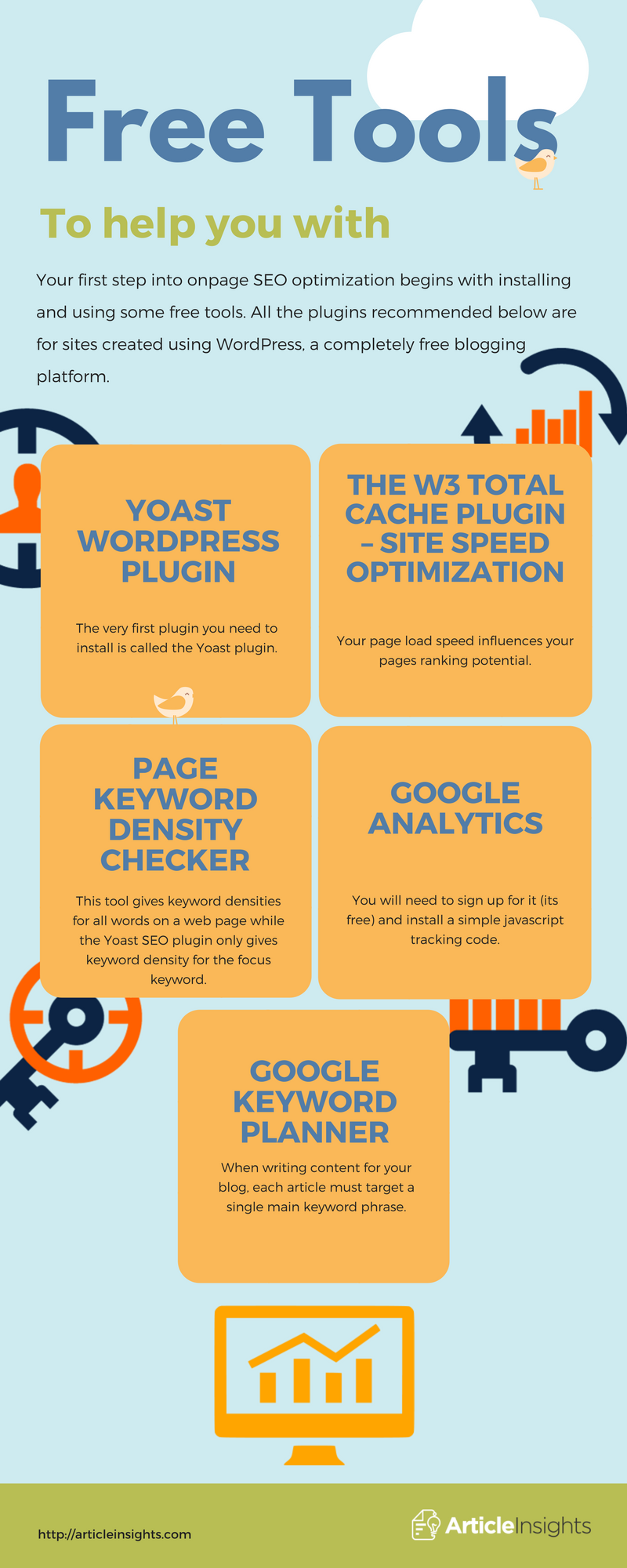

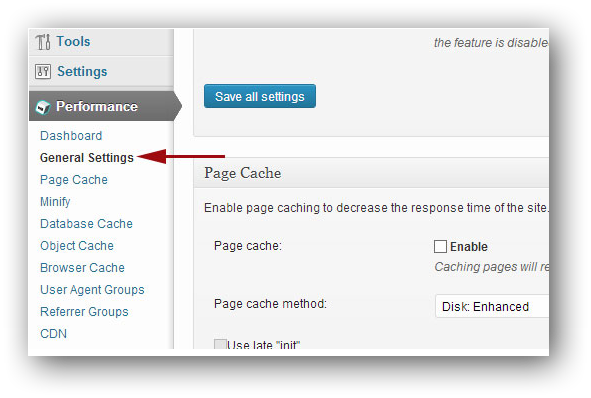
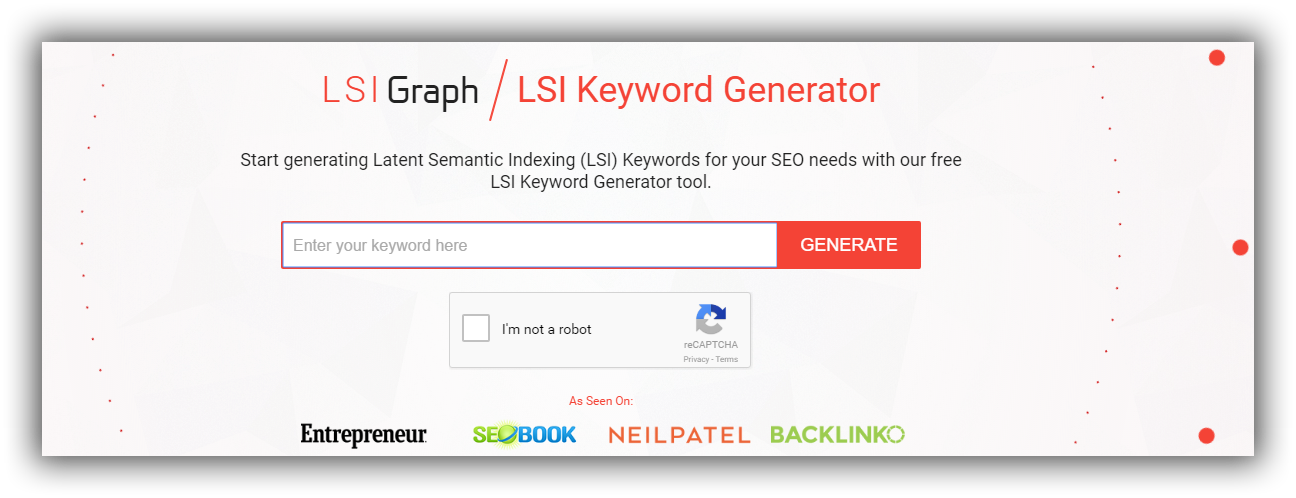

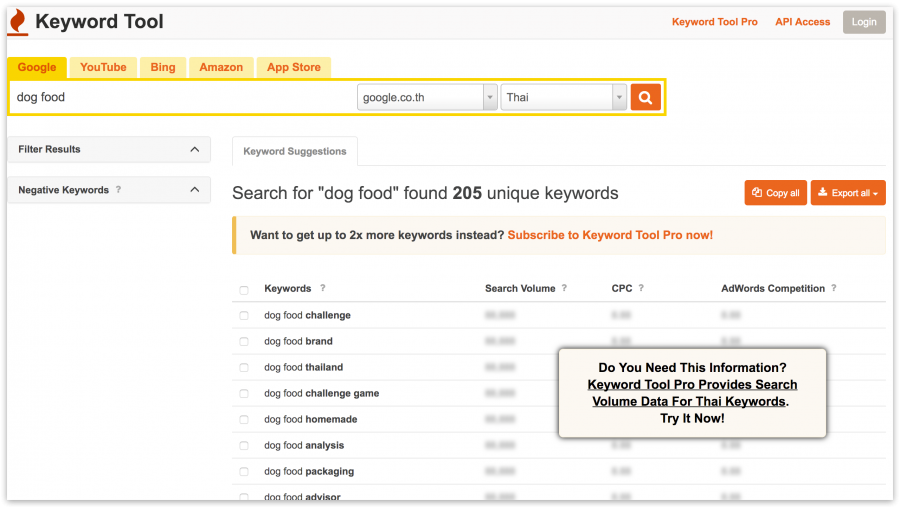

It is a good procedure to provide an informative wordings of On page with proper examples.
Hashtag internal linking….good idea!
Amazing info . Really awestrucked
Thanks for reading!
This article is very much helpful and i hope this will be an useful information for the needed one.Keep on updating these kinds of informative things…
Wonderful and useful article that helped for a nice keyword.